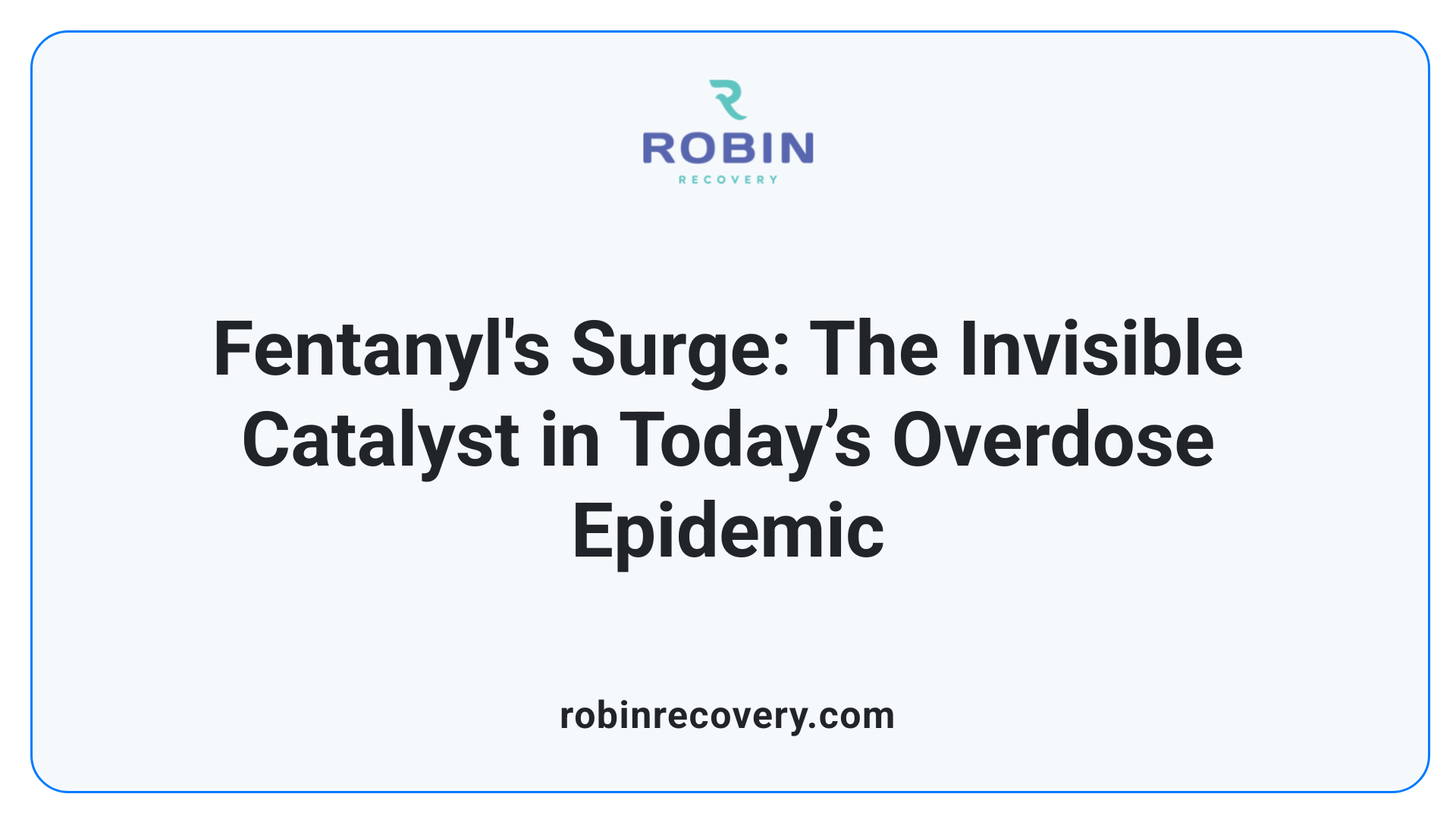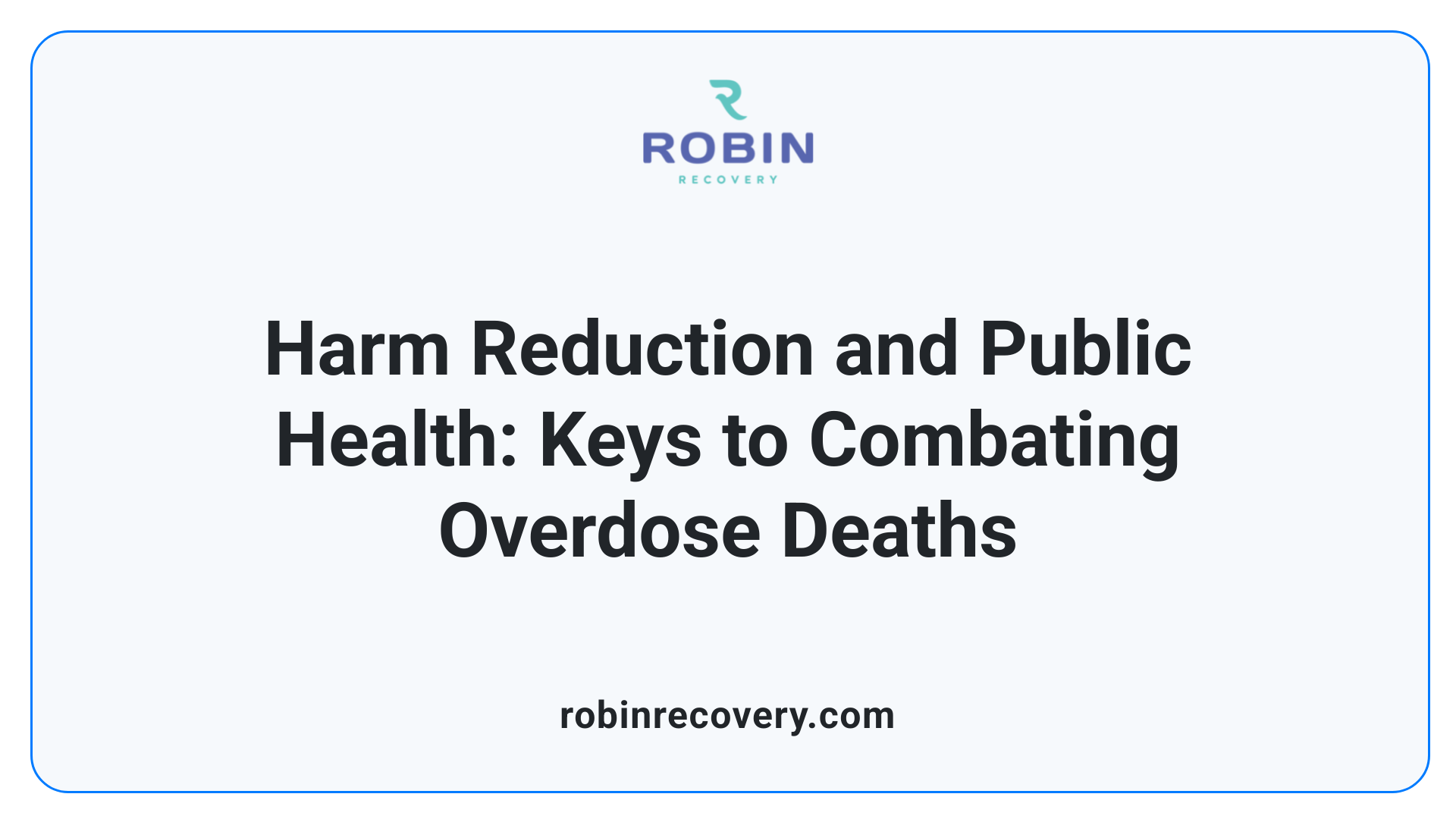America’s Killer Drugs – Which Drugs Cause the Most Overdose Deaths?

An In-Depth Look at the Leading Causes of Overdose Deaths in the U.S.
The opioid epidemic has shifted dramatically over recent years, with synthetic opioids, especially fentanyl, now at the forefront of overdose fatalities. This article explores the drugs most responsible for overdose deaths in America, analyzing trends, demographic disparities, and public health implications to provide a comprehensive understanding of this ongoing crisis.
The Dominance of Opioids in Overdose Deaths

What are the most responsible drugs for overdose deaths in the United States?
In the United States, opioids are overwhelmingly the primary contributors to overdose fatalities. In 2022, over 70% of all drug overdose deaths involved opioids, including heroin, prescription painkillers, and notably synthetic opioids like fentanyl. Fentanyl, a powerful synthetic opioid, was responsible for around 73,654 deaths in 2022, more than doubling the number from 2019. Its widespread presence, often mixed with other drugs or pressed into counterfeit pills, significantly amplifies the risk of overdose.
The surge in opioid-related deaths is driven by various factors, including the illicit manufacturing and smuggling of fentanyl, primarily into the US from foreign labs and across the Mexico border. The potency of fentanyl — which can be lethal in doses as small as two milligrams — makes it especially dangerous. Because of its high potency and the prevalence of counterfeit pills containing lethal amounts, it is a leading cause of overdose deaths nationwide.
What is the role of opioids, particularly fentanyl, in overdose mortality?
Opioids, especially fentanyl, are at the core of the ongoing overdose crisis. Fentanyl is responsible for approximately 76% of overdose deaths globally and over 70% in the US. Its incredible potency — being 50 to 100 times stronger than morphine and significantly more potent than heroin — makes it highly lethal.
Illicitly manufactured fentanyl is often mixed with heroin, cocaine, or methamphetamine, complicating overdose prevention efforts. Many counterfeit pills, which can look like legitimate prescription medications, contain dangerous amounts of fentanyl. Around 42% of tested counterfeit pills contain at least 2 milligrams of fentanyl, a potentially lethal dose.
This synthetic opioid's ability to cause rapid overdose and death has made it the leading drug involved in overdose fatalities. Public health responses emphasize the importance of widespread availability of naloxone, medication-assisted treatment, and harm reduction strategies to combat fentanyl-related overdoses.
Aspect Data Additional Details Responsible drugs Opioids (including fentanyl) Involved in over 80% of overdose deaths in the US in 2022 Fentanyl's role Major contributor Responsible for about 70%+ of overdose deaths; highly potent, illicitly manufactured Polysubstance use Common Fentanyl often found mixed with cocaine, methamphetamine, or pressed into counterfeit pills Variability in death rates Geographical disparities West Virginia leads with 60.8 per 100,000 people; nationwide overdose rate is 21.6 per 100,000
The continuing proliferation of synthetic opioids like fentanyl underscores the urgent need for comprehensive harm reduction, improved access to treatment, and targeted law enforcement strategies to reduce overdose deaths.
The Rise of Fentanyl and Synthetic Opioids

What do current statistics say about overdose death trends and the substances most involved?
Recent data reveals troubling trends in the U.S. opioid crisis. Overdose deaths involving stimulants like cocaine and methamphetamine are rising sharply since 2015, but the most significant increase is seen with synthetic opioids, particularly fentanyl. In 2022, fentanyl was linked to approximately 73,654 deaths—more than double the number in 2019—highlighting its dominant role in the epidemic.
Moreover, nearly 70% of all stimulant-related overdose fatalities in 2022 involved fentanyl, often mixed with other drugs. This indicates that fentanyl's reach extends across various drug categories, compounding the danger. The overall trend shows a move towards more lethal substances, driven by the widespread availability of illicit fentanyl.
What is the role of opioids, particularly fentanyl, in overdose mortality?
Fentanyl, a synthetic opioid about 50 to 100 times stronger than morphine, has become the primary driver of overdose deaths in recent years. Its high potency means that even tiny amounts—just about two milligrams—can be fatal. Most illicit fentanyl is manufactured outside the U.S., mainly in China, and enters the country via clandestine labs in Mexico.
Illicit fentanyl is often mixed with heroin, cocaine, or methamphetamine to enhance potency, frequently without the user's knowledge. It is pressed into counterfeit pills or sold as powders and nasal sprays, mimicking prescription medications. Because of its extreme strength and clandestine distribution, fentanyl has significantly shifted the landscape of drug-related mortality, turning synthetic opioids into the leading cause of overdose deaths nationwide.
Distribution channels and manufacturing sources
The widespread presence of fentanyl stems from its robust illicit manufacturing networks mostly located outside the U.S., with China being a major precursor chemical supplier. Fentanyl and its analogs are smuggled across the U.S.-Mexico border in various forms, often disguised as other substances.
Law enforcement reports indicate an exponential rise in seizures of counterfeit fentanyl pills—by over 264% in Washington State from 2020 to 2021—and a surge in overdose deaths aligned with these increased seizures. Similar patterns are seen nationally, with DEA data showing a 2700% increase in fentanyl seizures in Eastern Washington from 2017 to 2021.
Manufacturers produce fentanyl using precursor chemicals imported from China, which are then processed into potent powders or pressed into pills designed to look like legitimate prescription drugs. This ease of manufacturing, combined with the high profitability and lethality of fentanyl, fuels a continuously expanding supply chain that makes this synthetic opioid a major public health threat.
Aspect Details Additional Insights Potency Up to 100 times stronger than morphine Small doses can be lethal; 2 mg is sufficient for overdose Main source Mainly manufactured in China, smuggled through Mexico Illicit labs produce large quantities; precursor chemicals imported Distribution Sold as powders, counterfeit pills, nasal sprays Often mixed with other drugs without user knowledge Impact Responsible for over 70% of overdose deaths Rapidly increasing overdose death trends Law enforcement Seizure increases in various states 264% increase in pill seizures in Washington (2020-2021)
The progression of fentanyl’s production and distribution underscores the critical need for enhanced border security, law enforcement action, and harm reduction strategies to curb its devastating impact.
Demographic and Geographic Disparities in Overdose Fatalities

Current statistics reveal significant racial, age, and regional disparities in overdose death rates across the United States. In Minnesota, for instance, data from 2019 indicate that African Americans were nearly twice as likely to die from an overdose compared to whites, while American Indians faced an even higher risk, being seven times more likely to succumb to overdose than their white counterparts. These disparities highlight longstanding social and systemic inequities that influence access to healthcare and prevention services.
Regionally, states like West Virginia experience the highest overdose death rates, with 60.8 deaths per 100,000 residents, illustrating a pronounced rural and urban divide. The epidemic impacts both rural communities and densely populated urban areas, often hitting marginalized populations hardest.
Age and gender also play critical roles. Overdose deaths involving opioids remain the leading cause of death among Americans aged 18 to 45, with the majority of these fatalities involving males, who account for more than 71% of opioid-related deaths. Young adults are particularly vulnerable, especially with the rise of synthetic opioids like fentanyl, which is highly potent and easily concealed.
These disparities have serious public health implications. Marginalized groups often face barriers to accessing effective treatment, harm reduction tools like naloxone, and culturally competent healthcare. The widespread presence of fentanyl in the drug supply—often mixed with other substances—accelerates overdose risks across different demographic groups.
Addressing these disparities requires tailored interventions that consider racial, geographic, and age-related factors. Expanding access to naloxone, increasing community-based prevention programs, and improving healthcare equity are essential steps. Targeted efforts must also account for regional differences, focusing on high-risk areas such as West Virginia and certain cities where overdose mortality remains stubbornly high.
Overall, understanding these demographic patterns helps public health authorities develop more effective, localized strategies to combat the overdose crisis. It emphasizes the need for multisector collaborations that prioritize vulnerable populations and aim to reduce inequities that exacerbate the epidemic.
Polysubstance Use and Its Risks
What do current statistics say about overdose death trends and the substances most involved?
Recent data underscores a troubling rise in overdose deaths involving multiple substances. In 2022, nearly 108,000 Americans died from drug-involved overdoses, with over 70% involving opioids. Opioids like heroin, fentanyl, and various prescription pain medications are often found mixed with stimulants such as cocaine and methamphetamine. The trend shows an increased presence of benzodiazepines and other medications in overdose cases. Counterfeit pills contaminated with fentanyl are a major contributor, accounting for a significant portion of accidental poisonings. The pattern indicates a complex drug landscape where wide availability and adulteration increase risks.
What is the role of opioids, particularly fentanyl, in overdose mortality?
Fentanyl—an extremely potent synthetic opioid—plays a central role in the overdose crisis. Its illicit use has surged, with most fentanyl-related deaths involving synthetic fentanyl mixed with other drugs or pressed into counterfeit pills. The drug's high potency means that as little as two milligrams can be lethal, especially when unsuspected. Fentanyl’s proliferation, especially in powder and pill forms, has doubled overdose fatalities since 2019. Because it is often illicitly manufactured in foreign labs and smuggled into the U.S., its unpredictable presence in street drugs dramatically increases death risks. The widespread contamination of the drug supply with fentanyl underscores the urgent need for harm reduction and tighter control measures.
Public Health Measures and Harm Reduction Strategies

What do current statistics say about overdose death trends and the substances most involved?
Recent data indicates a significant decline in overdose deaths, with nearly a 24% decrease in the 12 months ending September 2024 compared to the previous year. This drop coincides with widespread efforts to increase naloxone distribution, expand access to medication-assisted treatment (MAT), and implement targeted prevention programs.However, despite this positive trend, the presence of highly potent substances like fentanyl continues to drive overdose mortality. In 2022, fentanyl was responsible for approximately 73,654 deaths in the U.S., more than doubling the number from 2019. It accounts for nearly 70% of all overdose deaths, often mixed with other drugs such as cocaine and methamphetamine, which complicates treatment and prevention efforts.Counterfeit pills containing fentanyl, often looking like legitimate prescription medications, are a major factor contributing to overdose deaths. Analysis shows 42% of tested pills contain at least 2 mg of fentanyl—potentially lethal doses. The illicit manufacture of fentanyl, mainly in foreign labs, and smuggling into the U.S. via Mexico has exacerbated this crisis.
What are the public health implications of rising overdose rates and drug use patterns?
The ongoing rise in overdose deaths underscores the need for comprehensive and adaptive public health strategies. Expanding medication-assisted treatment options and improving access to naloxone are essential to reduce fatalities.Investing in harm reduction initiatives such as anonymous drug testing, community distribution of naloxone, and public education about polysubstance risks can save lives. Moreover, addressing systemic barriers—like legal restrictions on naloxone and syringe programs—is vital.Efforts should also focus on data collection and analysis. Programs like CDC's Overdose Data to Action (OD2A) enable local jurisdictions to identify emerging drug trends swiftly and tailor interventions accordingly.Innovative policies, such as decriminalizing possession of small amounts and facilitating safe consumption spaces, could further decrease overdose mortality. Ensuring equity in access to treatment and prevention, especially for vulnerable populations disproportionately affected—such as African Americans, American Indians, and residents of high-risk regions like West Virginia—is imperative.By strengthening harm reduction policies and removing legal obstacles, the U.S. can continue to curb the overdose crisis and save countless lives.
The Future Outlook and Policy Directions
What do current statistics say about overdose death trends and the substances most involved?
Provisional CDC data shows a promising trend with a nearly 24% decrease in overdose deaths over the 12 months ending September 2024, totaling approximately 87,000 deaths. This decline is attributed to enhanced harm reduction strategies, broader access to life-saving interventions like naloxone, and better control over illicit drug supplies, especially fentanyl.However, the landscape remains complex. Synthetic opioids, particularly fentanyl, continue to dominate overdose fatalities, accounting for about 70% of deaths. The number of fentanyl-related deaths, although now showing signs of decline, remains high, with recent data indicating a decrease of at least 21% in 2023 after years of exponential growth. This highlights that while progress is being made, the challenge of fentanyl’s potency and widespread illicit manufacturing persists.Additionally, overdose deaths involving stimulants such as cocaine and methamphetamine remain high, with figures around 27,569 and 34,022 respectively in 2022. Polysubstance use, especially opioids combined with stimulants or benzodiazepines, continues to complicate treatment and prevention efforts.
What are the public health implications of rising overdose rates and drug use patterns?
The evolving patterns of drug use demand sustained, adaptable public health responses. Controlling supply chains, particularly of illicit fentanyl, remains crucial. Expanding harm reduction services, including widespread distribution of naloxone and fentanyl test strips, can prevent many deaths.Equity considerations are also vital. Disparities in overdose rates among different racial and age groups highlight the need for targeted interventions. For instance, American Indians and African Americans experience disproportionate impacts, driven by systemic factors like healthcare access and social determinants.International experiences offer lessons. Countries like Portugal and Norway have successfully implemented peer distribution programs and comprehensive treatment policies that reduce overdose rates. These models emphasize community involvement and reducing stigma, which could be adapted within the U.S. context.Looking ahead, integrating data-driven approaches, such as the CDC’s Overdose Data to Action program, will be essential for tracking emerging substances and tailoring response strategies. Combining supply control with expanded treatment and community-supported harm reduction offers the best path forward to curb the persistent overdose epidemic.
The Global Context and How the U.S. Stacks Up
What are the most responsible drugs for overdose deaths in the United States?
The United States faces a severe overdose crisis, primarily driven by synthetic opioids like fentanyl. Unlike many other countries where heroin or prescription opioids are the main culprits, the U.S. is uniquely affected by the proliferation of illicit fentanyl. This potent synthetic opioid is often mixed with other drugs, such as cocaine and methamphetamine, increasing the risk of overdose.
While some nations have successfully reduced overdose deaths through harm reduction policies—such as widespread naloxone distribution, supervised consumption sites, and robust treatment programs—the U.S. continues to struggle with high overdose rates largely due to illegal fentanyl production and distribution. This drug’s extreme potency, where just two milligrams is lethal, contributes significantly to the high number of deaths.
What do current statistics say about overdose death trends and the substances most involved?
Globally, overdose patterns vary, but the U.S. stands out with the highest per capita overdose mortality rate. In 2023, over 100,000 Americans died from drug overdoses, representing roughly 21.6 deaths per 100,000 residents—a rate significantly higher than other countries. The vast majority of these deaths involve opioids, notably synthetic varieties like fentanyl, which accounted for nearly 70% of overdose deaths in 2022.
The trend shows a sharp increase in overdose deaths involving synthetic opioids—especially from 2019 to 2022—highlighting the evolving landscape of drug misuse. While other countries see declines through comprehensive harm reduction approaches, the rising availability of illicit fentanyl in the U.S. sustains overwhelming overdose mortality.
Comparing International Strategies
Various countries have adopted effective harm reduction strategies to combat overdose deaths. Portugal’s decriminalization policy, for instance, and Switzerland’s widespread distribution of naloxone and supervised injection facilities have contributed to reductions in overdose deaths.
In contrast, the U.S. has limitations rooted in legal and policy barriers that restrict access to harm reduction tools like naloxone and fentanyl test strips. Countries like Norway and Scotland have higher rates of opioid substitution therapy, reducing overdose mortality significantly.
Lessons from Abroad
The U.S. could benefit from adopting and expanding evidence-based policies proven effective elsewhere. Increasing access to medication-assisted treatment (MAT), expanding harm reduction programs, and adopting supportive legal frameworks are critical steps.
International efforts highlight the importance of community-based approaches, public health campaigns, and robust data collection—similar to the CDC’s Overdose Data to Action (OD2A) program—that can help identify emerging drug threats and tailor intervention strategies accordingly.
In summary, understanding how other nations manage their overdose crises offers valuable insights. Enhanced cooperation, policy innovation, and comprehensive harm reduction can pave the way for meaningful progress in reducing overdose deaths in the United States.
Addressing the Overdose Epidemic: A Call to Action
The surge in overdose deaths driven by fentanyl and other synthetic opioids underscores the urgent need for comprehensive public health strategies. Expanding harm reduction, improving access to treatment, and strengthening legal policies are essential steps to curb this devastating crisis and save lives across all communities.
References
- Drug Overdose Deaths: Facts and Figures
- CDC Reports Nearly 24% Decline in U.S. Drug Overdose Deaths
- Drug Overdose Dashboard - Fatal Overdoses | Missouri Department ...
- Facts about Fentanyl - DEA
- Differences in Rates of Drug Overdose Deaths by Race
- Opioid overdose - World Health Organization (WHO)
- Operation Engage Spokane - DEA
- Are fentanyl overdose deaths rising in the US? - USAFacts
- Why Baltimore is seeing more drug overdose deaths than any ... - PBS
- Drug Overdose Death Statistics [2023]: Opioids, Fentanyl & More
